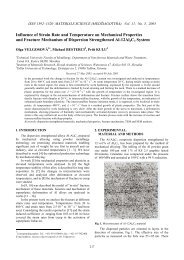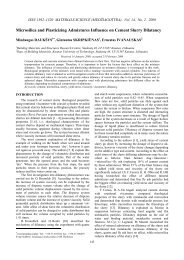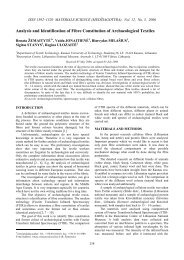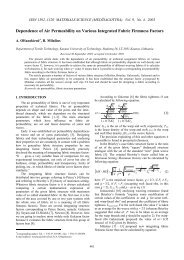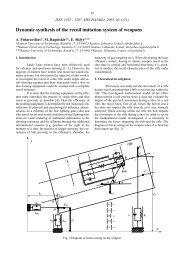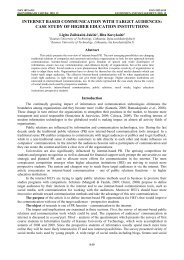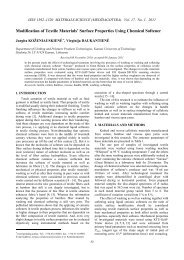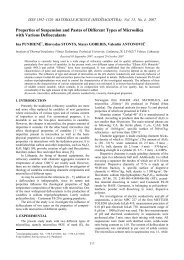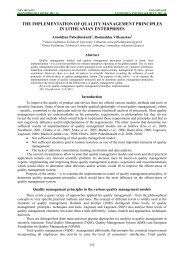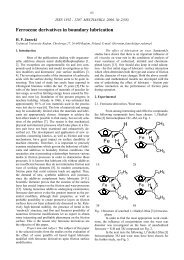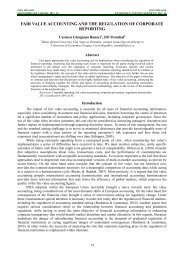Estimation of Chrome-free Tanning Method Suitability in Conformity ...
Estimation of Chrome-free Tanning Method Suitability in Conformity ...
Estimation of Chrome-free Tanning Method Suitability in Conformity ...
Create successful ePaper yourself
Turn your PDF publications into a flip-book with our unique Google optimized e-Paper software.
ISSN 1392–1320 MATERIALS SCIENCE (MEDŽIAGOTYRA). Vol. 16, No. 4. 2010<br />
<strong>Estimation</strong> <strong>of</strong> <strong>Chrome</strong>-<strong>free</strong> <strong>Tann<strong>in</strong>g</strong> <strong>Method</strong> <strong>Suitability</strong> <strong>in</strong> <strong>Conformity</strong><br />
with Physical and Chemical Properties <strong>of</strong> Leather<br />
Virgilijus VALEIKA 1 ∗ , Justa ŠIRVAITYTĖ 2 , Kęstutis BELEŠKA 2<br />
Department <strong>of</strong> General Chemistry 1 , Department <strong>of</strong> Organic Technology 2 , Kaunas University <strong>of</strong> Technology,<br />
Radvilenų pl. 19, LT-50254 Kaunas, Lithuania<br />
Received 19 April 2010; accepted 28 October 2010<br />
The change <strong>of</strong> tann<strong>in</strong>g parameters reflects on leather chemical and physical properties. The standardized<br />
determ<strong>in</strong>ation methods <strong>of</strong> more important for customers leather <strong>in</strong>dexes do not allow absolutely clear to conclude about<br />
suitability <strong>of</strong> developed tann<strong>in</strong>g method for leather process<strong>in</strong>g. Due to this DSC analysis and IR spectroscopy were<br />
employed as additionally analyses methods for the clarification <strong>of</strong> tann<strong>in</strong>g process <strong>in</strong>fluence on leather qualitative<br />
properties.<br />
Dur<strong>in</strong>g research established structural characteristics <strong>of</strong> variously tanned leather show how differently tann<strong>in</strong>g<br />
materials jo<strong>in</strong> to derma collagen and prove that content <strong>of</strong> l<strong>in</strong>ked tann<strong>in</strong>g materials is not most important factor, which<br />
orda<strong>in</strong>s the thermo stability <strong>of</strong> collagen, <strong>in</strong> the case <strong>of</strong> chrome-<strong>free</strong> tann<strong>in</strong>g. The results <strong>of</strong> DSC and IR-spectroscopy<br />
clarify the data obta<strong>in</strong>ed by other <strong>in</strong>vestigation methods and allow more exactly estimation <strong>of</strong> the tann<strong>in</strong>g method<br />
suitability for leather process<strong>in</strong>g. It was established that variation <strong>of</strong> vegetable tann<strong>in</strong>s <strong>in</strong> tann<strong>in</strong>g recipe <strong>in</strong>fluences on<br />
leather properties and best results are obta<strong>in</strong>ed us<strong>in</strong>g mimosa tann<strong>in</strong>s.<br />
Keywords: leather, chrome-<strong>free</strong> tann<strong>in</strong>g, tann<strong>in</strong>, shr<strong>in</strong>kage temperature, thermo stability.<br />
INTRODUCTION 1<br />
Natural leather is processed from hides and sk<strong>in</strong>s <strong>of</strong><br />
animals. There is a need to understand the properties <strong>of</strong><br />
processed natural leather to select proper material for an<br />
application. Dur<strong>in</strong>g the past 20 years, leather researchers<br />
have used experimental and theoretical approaches to<br />
<strong>in</strong>vestigate several methods for stabiliz<strong>in</strong>g collagen<br />
structure. Insight ga<strong>in</strong>ed from these studies and those <strong>of</strong><br />
leather and biomaterials scientists will be evaluated as<br />
steps toward a still elusive, comprehensive mechanism for<br />
stabilization <strong>of</strong> collagen <strong>in</strong> leather and other biomaterials.<br />
The ma<strong>in</strong> process <strong>of</strong> sk<strong>in</strong> or hide convert<strong>in</strong>g <strong>in</strong>to<br />
leather is tann<strong>in</strong>g. Chromium has been used as primary<br />
tannage for many leathers for over 100 years. In the early<br />
days the tann<strong>in</strong>g form, Cr(III), was produced from Cr(VI)<br />
by reduction <strong>of</strong> the chrome by sugars at low pH. When<br />
basic chrome sulphate was <strong>in</strong>troduced as a product ready to<br />
be used for tann<strong>in</strong>g, tanneries changed to the use <strong>of</strong> these<br />
products either as an aqueous solution or a dry product [1].<br />
Dur<strong>in</strong>g the last 20 years new tann<strong>in</strong>g methods, which allow<br />
avoidance <strong>of</strong> toxic chromium compounds, have been<br />
developed. Although such tann<strong>in</strong>g methods enable the<br />
avoidance <strong>of</strong> chromium compounds, it does not mean that<br />
the leather is <strong>free</strong> from <strong>in</strong>organic salts (alum<strong>in</strong>ium, silicon,<br />
titanium etc.). Due to <strong>in</strong>creas<strong>in</strong>gly strict requirements for<br />
leather and with regard to recycl<strong>in</strong>g <strong>of</strong> leather wastes, the<br />
manufacture chromium-<strong>free</strong> leather becomes very<br />
important [2]. Develop<strong>in</strong>g <strong>of</strong> environmentally friendly<br />
tann<strong>in</strong>g technologies, most perspective is the comb<strong>in</strong>ation<br />
<strong>of</strong> <strong>in</strong>organic (alum<strong>in</strong>ium, silica, z<strong>in</strong>c etc.) and organic<br />
(vegetable tann<strong>in</strong>s, res<strong>in</strong>s, aldehydes etc) chrome-<strong>free</strong><br />
materials [3 – 6]. On the other hand, mostly researches<br />
limit the <strong>in</strong>vestigation evaluat<strong>in</strong>g those leather properties,<br />
which are most important for consumers such as shr<strong>in</strong>kage<br />
1 Correspond<strong>in</strong>g author: Tel.: +370-37-300189; fax: +370-37-300152.<br />
E-mail address: virgilijus.valeika@ktu.lt (V. Valeika)<br />
330<br />
temperature and strength properties, and few chemical<br />
<strong>in</strong>dexes like as content <strong>of</strong> chromium <strong>in</strong> leather, content <strong>of</strong><br />
volatile or extractable with dichloromethane materials. Of<br />
course, these <strong>in</strong>dexes also are very important, but their<br />
values are determ<strong>in</strong>ed by changes <strong>in</strong> derma structure which<br />
are occurred dur<strong>in</strong>g leather process<strong>in</strong>g. Any change <strong>of</strong><br />
leather manufacture process reflects on derma structure<br />
and <strong>in</strong>fluences the f<strong>in</strong>al properties <strong>of</strong> leather. Development<br />
<strong>of</strong> new and more environmentally friendly technologies <strong>of</strong><br />
leather process<strong>in</strong>g leads to markedly differences <strong>in</strong> leather<br />
structure compar<strong>in</strong>g with leather processed under<br />
conventional technologies.<br />
The aim <strong>of</strong> this research was the <strong>in</strong>vestigation <strong>of</strong><br />
leather structural properties dependence on chrome-<strong>free</strong><br />
materials used for tann<strong>in</strong>g process and estimation <strong>of</strong><br />
chrome-<strong>free</strong> tann<strong>in</strong>g method suitability <strong>in</strong> conformity with<br />
physical and chemical properties <strong>of</strong> leather.<br />
EXPERIMENTAL PROCEDURES<br />
Parameters <strong>of</strong> processes<br />
Salted cattle hide was used as a raw material. The<br />
samples for the <strong>in</strong>vestigation were taken from lower part <strong>of</strong><br />
the hide. The parameters <strong>of</strong> hide process<strong>in</strong>g are presented<br />
<strong>in</strong> Table 1.<br />
The pelt after preparation to tann<strong>in</strong>g process was cut<br />
<strong>in</strong>to pieces (5 × 10) cm and 7 equal series <strong>of</strong> samples were<br />
formed from these pieces. Also, the solution dra<strong>in</strong>ed after<br />
the preparation to tann<strong>in</strong>g (“weak pickle”) was divided <strong>in</strong>to<br />
7 equal parts and used for tann<strong>in</strong>g, which was carried out<br />
<strong>in</strong> the follow<strong>in</strong>g ways (material amount, % on pelt mass):<br />
Variant 1 – a) the solution from the preparation to<br />
tann<strong>in</strong>g stage was diluted with H 2 O 160 %, temperature<br />
25 °C, Na 2 SiO 3 1 % (reckoned as SiO 2 ), duration 2 h, run<br />
cont<strong>in</strong>uously;<br />
b) Quebracho (Tanac S.A, Brasil) vegetable tann<strong>in</strong>s<br />
30 %, duration 24 h, run cont<strong>in</strong>uously;
Table 1. Processes before tann<strong>in</strong>g<br />
Process title<br />
Process parameters<br />
Material title and amount, % on hide (pelt) mass Temperature, °C Duration and regime<br />
Wash<strong>in</strong>g H 2 O – 200 23 – 25 1 h run cont<strong>in</strong>uously<br />
Soak<strong>in</strong>g H 2 O – 200, Na 2 CO 3 (100 %) – 1.35 23 – 25<br />
1.5 h run cont<strong>in</strong>uously;<br />
later 5 m<strong>in</strong>. every 1 h. Total – 12 h.<br />
Lim<strong>in</strong>g and<br />
open<strong>in</strong>g up <strong>of</strong><br />
derma structure<br />
H 2 O – 100, non-ionic surfactant – 0.1;<br />
Ca(OH) 2 (100 %) – 2.3, Na 2 S (100 %) – 2;<br />
Ca(OH) 2 (100 %) – 2.3;<br />
H 2 O – 100<br />
25 – 27<br />
30 m<strong>in</strong> run cont<strong>in</strong>uously;<br />
1.5 h run cont<strong>in</strong>uously;<br />
1 h run cont<strong>in</strong>uously;<br />
17 h run cont<strong>in</strong>uously.<br />
Wash<strong>in</strong>g H 2 O – 400 25 – 27 1 h run cont<strong>in</strong>uously<br />
Delim<strong>in</strong>g and<br />
bat<strong>in</strong>g*<br />
H 2 O – 40, CH 3 COOOH (peracetic acid) (100 %) –<br />
0.75; Enzyme preparation Novo Bate WB – 0.30<br />
35 – 37<br />
1 h run cont<strong>in</strong>uously;<br />
1 h run cont<strong>in</strong>uously.<br />
Wash<strong>in</strong>g H 2 O – 200 20 – 25 0.5 h run cont<strong>in</strong>uously<br />
Preparation to<br />
tann<strong>in</strong>g “weak<br />
pickle”*<br />
H 2 O – 40, NaCl – 5.5;<br />
HCOONa – 1;<br />
H 2 SO 4 (98 %) – 0.5<br />
20 – 22<br />
* Delim<strong>in</strong>g, bat<strong>in</strong>g and preparation to tann<strong>in</strong>g were carried out under conditions described <strong>in</strong> literature [7, 8].<br />
20 m<strong>in</strong> run cont<strong>in</strong>uously;<br />
15 m<strong>in</strong> run cont<strong>in</strong>uously;<br />
5.5 h run cont<strong>in</strong>uously.<br />
c) KAl(SO 4 ) 2 · 12H 2 O 1.5 % (reckoned as Al 2 O 3 ),<br />
duration 6 h, run cont<strong>in</strong>uously;<br />
d) Na 2 CO 3 1 %, duration 15 m<strong>in</strong>, run cont<strong>in</strong>uously;<br />
e) Na 2 CO 3 1 %, duration 15 m<strong>in</strong>, run cont<strong>in</strong>uously;<br />
f) Na 2 CO 3 1 %, duration 45 m<strong>in</strong>, run cont<strong>in</strong>uously;<br />
Variant 2 – as (1), replac<strong>in</strong>g Quebracho by Mimosa<br />
(Tanac S.A, Brasil) vegetable tann<strong>in</strong>s 30 %;<br />
Variant 3 – as (1), replac<strong>in</strong>g all Quebracho by<br />
Quebracho 15 % and Mimosa 15 %;<br />
Variant 4 – as (1), replac<strong>in</strong>g all Quebracho by<br />
Quebracho 21 % and Mimosa 9 %;<br />
Variant 5 – as (1), replac<strong>in</strong>g all Quebracho by<br />
Quebracho 9 % and Mimosa 21 %;<br />
Variant 6 – as (1), replac<strong>in</strong>g Quebracho by Chestnut<br />
(Tanac S.A, Brasil) tann<strong>in</strong>s 9 % and Mimosa 21 %;<br />
Variant 7 (control) – a) temperature 20 °C – 22 °C,<br />
<strong>Chrome</strong>co Extra (Gruppo Chimico Dalton, Italy) 1.5 %<br />
(reckoned as Cr 2 O 3 ), duration 12 h, run cont<strong>in</strong>uously;<br />
b) Neutragene MG-120 (Codyeco s.p.a., Italy) 0.25 %,<br />
duration 2 h, run cont<strong>in</strong>uously;<br />
c) Neutragene MG-120 0.25 %, duration 2 h, run<br />
cont<strong>in</strong>uously;<br />
d) H 2 O 40 %, temperature 55 °C, duration 1 h, run<br />
cont<strong>in</strong>uously.<br />
All samples after tann<strong>in</strong>g were stored dur<strong>in</strong>g 48 h.<br />
Commercial products used <strong>in</strong> the processes<br />
a) Enzyme preparation Novo Bate WB (Novozymes,<br />
Denmark) is a bacterial protease produced by submerged<br />
fermentation <strong>of</strong> a Bacillus micro organism, which is<br />
commonly applied <strong>in</strong> the re-bat<strong>in</strong>g process <strong>of</strong> wet-blue<br />
stock.<br />
b) Quebracho, Mimosa and Chestnut (Tanac S.A,<br />
Brasil) vegetable tann<strong>in</strong>s are commonly applied <strong>in</strong><br />
vegetable tann<strong>in</strong>g or retann<strong>in</strong>g.<br />
c) <strong>Chrome</strong>co Extra (Gruppo Chimico Dalton, Italy) is<br />
chrom<strong>in</strong>g material hav<strong>in</strong>g 33 % basicity.<br />
d) Neutragene MG-120 (Codyeco s.p.a., Italy) is a<br />
material applied for <strong>in</strong>creas<strong>in</strong>g <strong>of</strong> chromium compounds<br />
basicity, high chrome fixation and uniform distribution,<br />
conta<strong>in</strong><strong>in</strong>g magnesium oxide.<br />
Chemicals<br />
Chemically and analytically pure chemicals without<br />
any additional preparation were used carry<strong>in</strong>g out analyses.<br />
<strong>Method</strong>s and analyses<br />
The shr<strong>in</strong>kage temperature <strong>of</strong> leather was measured<br />
us<strong>in</strong>g special equipment [9].<br />
Content and exhaustion <strong>of</strong> organic and <strong>in</strong>organic<br />
matter <strong>in</strong> leather were determ<strong>in</strong>ed accord<strong>in</strong>g to the<br />
methods described <strong>in</strong> literature [9]. Content <strong>of</strong> chromium<br />
compounds <strong>in</strong> leather was determ<strong>in</strong>ed by method described<br />
<strong>in</strong> [10].<br />
The physical and mechanical properties were<br />
determ<strong>in</strong>ed accord<strong>in</strong>g to standard [11].<br />
An <strong>in</strong>frared (FTIR) reflection spectrum was obta<strong>in</strong>ed<br />
us<strong>in</strong>g a Perk<strong>in</strong>-Elmer FTIR Spectrum GX (USA) spectrometer<br />
us<strong>in</strong>g KBr pellets. The resolution 1 cm –1 , scan rate<br />
0.2 cm/s and scan number 16 times. The s<strong>of</strong>tware<br />
”Spectrum 5.0.1“ was used calculat<strong>in</strong>g the area <strong>of</strong> peaks <strong>in</strong><br />
spectra ∆S (T%·cm –1 ).<br />
Differential scann<strong>in</strong>g calorimetry (DSC) analysis was<br />
performed with the Netzsch Gerätebau GmbH (Germany)<br />
thermal analyzer <strong>in</strong> nitrogen atmosphere at the heat<strong>in</strong>g rate<br />
<strong>of</strong> – 10 °C/m<strong>in</strong>.<br />
Statistical analysis<br />
All data were expressed as the mean <strong>in</strong>dicat<strong>in</strong>g<br />
standard error <strong>of</strong> triplicate measurements. Confidence<br />
limits were set at P < 0.05. Standard deviations did not<br />
exceed 5 % for the majority <strong>of</strong> the values obta<strong>in</strong>ed.<br />
RESULTS AND DISCUSSIONS<br />
The knowledge <strong>of</strong> the character <strong>of</strong> crossl<strong>in</strong>k<strong>in</strong>g bonds<br />
is <strong>of</strong> great importance to the tann<strong>in</strong>g chemistry. The<br />
formation <strong>of</strong> such bonds decreases the solubility <strong>of</strong><br />
collagen, which <strong>in</strong>creases the shr<strong>in</strong>kage temperature and<br />
<strong>in</strong>fluences many other properties.<br />
331
120<br />
After tann<strong>in</strong>g After tann<strong>in</strong>g and 24 h stor<strong>in</strong>g After tann<strong>in</strong>g and 48 h stor<strong>in</strong>g<br />
100<br />
Shr<strong>in</strong>kage temperature, o C<br />
80<br />
60<br />
40<br />
20<br />
0<br />
1 2 3 4 5 6 7<br />
<strong>Tann<strong>in</strong>g</strong> variants<br />
Fig. 1. Dependence <strong>of</strong> leather shr<strong>in</strong>kage temperature on tann<strong>in</strong>g method<br />
The change from the soluble to the <strong>in</strong>soluble fibrous<br />
state is an essential biological requirement for crossl<strong>in</strong>k<strong>in</strong>g<br />
[12]. Due to this, the shr<strong>in</strong>kage temperature rema<strong>in</strong>s as<br />
important <strong>in</strong>dex, which reflects quantity <strong>of</strong> new bonds<br />
formed <strong>in</strong> collagen and quality <strong>of</strong> tann<strong>in</strong>g and tanned<br />
leather. Usually, users <strong>of</strong> leather, as raw material for shoes,<br />
garment or other, require the shr<strong>in</strong>kage temperature <strong>of</strong><br />
leather to be not less than 100 °C. Such temperature is<br />
reached lightly when chrome compounds use <strong>in</strong> tann<strong>in</strong>g<br />
process. On the other hand, the reach<strong>in</strong>g <strong>of</strong> such shr<strong>in</strong>kage<br />
temperature us<strong>in</strong>g chrome <strong>free</strong> tann<strong>in</strong>g materials is more<br />
complicated due to different crossl<strong>in</strong>k<strong>in</strong>g abilities <strong>of</strong><br />
various tann<strong>in</strong>g materials. Only comb<strong>in</strong><strong>in</strong>g different<br />
chrome <strong>free</strong> tann<strong>in</strong>g materials for tann<strong>in</strong>g the needful<br />
thermal stability can be obta<strong>in</strong>ed [13 – 15]. It is the reason<br />
why the comb<strong>in</strong>ations <strong>of</strong> <strong>in</strong>organic and organic chrome<br />
<strong>free</strong> agents was used <strong>in</strong> experiment.<br />
The determ<strong>in</strong>ation <strong>of</strong> leather shr<strong>in</strong>kage temperature<br />
has shown (Fig. 1, tann<strong>in</strong>g variants correspond to the<br />
methods described <strong>in</strong> chapter Experimental procedures)<br />
that vary<strong>in</strong>g comb<strong>in</strong>ations <strong>of</strong> chrome <strong>free</strong> tann<strong>in</strong>g materials<br />
can be achieved even 100 °C shr<strong>in</strong>kage temperature. On<br />
the other hand, there are some differences between chrome<br />
and chrome-<strong>free</strong> tann<strong>in</strong>g.<br />
The chrome tann<strong>in</strong>g allows reach<strong>in</strong>g high shr<strong>in</strong>kage<br />
temperature dur<strong>in</strong>g tann<strong>in</strong>g. The <strong>in</strong>crease <strong>of</strong> shr<strong>in</strong>kage<br />
temperature dur<strong>in</strong>g 24 h <strong>of</strong> chromed leather stor<strong>in</strong>g is<br />
negligible: only 2.3 °C. Dur<strong>in</strong>g next 24 h <strong>of</strong> stor<strong>in</strong>g the<br />
shr<strong>in</strong>kage temperature does not change more. Due to the<br />
high crossl<strong>in</strong>k<strong>in</strong>g ability <strong>of</strong> chromium compounds the<br />
formation <strong>of</strong> cross l<strong>in</strong>ks goes on fast and qualitative.<br />
Different image we have us<strong>in</strong>g chrome-<strong>free</strong> materials.<br />
Independently on tann<strong>in</strong>g comb<strong>in</strong>ation the shr<strong>in</strong>kage<br />
temperature after tann<strong>in</strong>g process reaches only<br />
77 °C – 81 °C. However, the process <strong>of</strong> crossl<strong>in</strong>k<strong>in</strong>g does<br />
not stop after end<strong>in</strong>g <strong>of</strong> tann<strong>in</strong>g and <strong>in</strong>tensive goes on<br />
when leather is stor<strong>in</strong>g. The shr<strong>in</strong>kage temperature<br />
<strong>in</strong>creases 17 °C – 20 °C dur<strong>in</strong>g first 24 h <strong>of</strong> stor<strong>in</strong>g and<br />
additionally 0.5 °C – 2.3 °C dur<strong>in</strong>g next 24 h up to 96 °C –<br />
101 °C. Authors suppose that when stor<strong>in</strong>g tanned by<br />
chrome-<strong>free</strong> materials leather the formation <strong>of</strong> l<strong>in</strong>ks goes<br />
on not only between tann<strong>in</strong>g agents and collagen active<br />
groups. The additionally l<strong>in</strong>k<strong>in</strong>g between tann<strong>in</strong>g complexes,<br />
which are jo<strong>in</strong>ed to the collagen by one l<strong>in</strong>k, takes<br />
place and forms new cross l<strong>in</strong>ks jo<strong>in</strong><strong>in</strong>g adjacent cha<strong>in</strong>s <strong>of</strong><br />
collagen like as <strong>in</strong> the case <strong>of</strong> comb<strong>in</strong>ation tann<strong>in</strong>g with<br />
alum<strong>in</strong>ium-phosphonium-vegetable tann<strong>in</strong>s [2].<br />
The highest shr<strong>in</strong>kage temperature was reached us<strong>in</strong>g<br />
Mimosa or mixtures <strong>of</strong> Quebracho and Mimosa vegetable<br />
tann<strong>in</strong>s (tann<strong>in</strong>g variant 2 and 3) but, summaris<strong>in</strong>g, could<br />
be noted that other chrome-<strong>free</strong> tann<strong>in</strong>g variants allowed to<br />
reach sufficiently high shr<strong>in</strong>kage temperature.<br />
The evaluation <strong>of</strong> organic and <strong>in</strong>organic matter was<br />
second step mak<strong>in</strong>g the image <strong>of</strong> crossl<strong>in</strong>k<strong>in</strong>g process <strong>in</strong><br />
leather more perspicuous. Data <strong>in</strong> Table 2 show that there<br />
is no direct dependence between exhaustion <strong>of</strong> tann<strong>in</strong>g<br />
materials and amounts <strong>of</strong> l<strong>in</strong>ked organic and <strong>in</strong>organic<br />
matter <strong>in</strong> tanned leather. It means that part <strong>of</strong> tann<strong>in</strong>g<br />
materials, which gets <strong>in</strong>to leather, is not l<strong>in</strong>ked overall or is<br />
l<strong>in</strong>ked weakly and removes dur<strong>in</strong>g wash<strong>in</strong>g with water. On<br />
the other hand, the bigger amount <strong>of</strong> l<strong>in</strong>ked tann<strong>in</strong>g<br />
materials either organic or <strong>in</strong>organic does not decide<br />
higher shr<strong>in</strong>kage temperature <strong>of</strong> leather. This once more<br />
confirms the proposition that somewhat tann<strong>in</strong>g complexes<br />
are l<strong>in</strong>ked to the collagen by one l<strong>in</strong>k without jo<strong>in</strong><strong>in</strong>g <strong>of</strong><br />
adjacent cha<strong>in</strong>s <strong>of</strong> collagen and, consequently, has not<br />
<strong>in</strong>fluence on the <strong>in</strong>crease <strong>of</strong> shr<strong>in</strong>kage temperature.<br />
Due to this better tann<strong>in</strong>g effect can be obta<strong>in</strong>ed not by<br />
<strong>in</strong>creas<strong>in</strong>g <strong>of</strong> <strong>in</strong>itial amounts <strong>of</strong> tann<strong>in</strong>g materials but<br />
through the change <strong>of</strong> tann<strong>in</strong>g process conditions, which<br />
necessitates better l<strong>in</strong>k<strong>in</strong>g <strong>of</strong> tann<strong>in</strong>g materials.<br />
The strength properties <strong>of</strong> leather are almost most<br />
important decid<strong>in</strong>g about quality <strong>of</strong> manufactured leather.<br />
We can process the leather with good chemical properties<br />
but it is not suitable for customers if strength properties are<br />
not sufficiently good.<br />
332
Table 2. Content <strong>of</strong> organic and <strong>in</strong>organic matter <strong>in</strong> tanned leather<br />
Index<br />
<strong>Tann<strong>in</strong>g</strong> variants<br />
1 2 3 4 5 6 7<br />
Amount <strong>of</strong> l<strong>in</strong>ked organic matter, %* 23.5 22.2 26.2 29.6 25.5 21.9 –<br />
Exhaustion <strong>of</strong> tann<strong>in</strong>s, % 72.9 77.6 74.3 75.8 76.4 70.3 –<br />
Amount <strong>of</strong> l<strong>in</strong>ked <strong>in</strong>organic matter, %* 2.7 3.0 3.1 3.3 3.2 3.0 5.4<br />
Exhaustion <strong>of</strong> <strong>in</strong>organic tann<strong>in</strong>g materials, % 57.5 62.3 58.6 57.0 55.8 58.0 82.5<br />
* Percentage is counted on absolutely dry leather.<br />
Table 3. Dependence <strong>of</strong> strength properties <strong>of</strong> leather on tann<strong>in</strong>g method<br />
Index<br />
<strong>Tann<strong>in</strong>g</strong> variants<br />
1 2 3 4 5 6 7<br />
Tensile strength, N/mm 2 15.2 12.8 11.9 12.3 13.3 12.6 18.3<br />
Stra<strong>in</strong> when gra<strong>in</strong> layer breaks, N/mm 2 14.5 12.0 11.2 12.2 13.3 12.6 15.5<br />
16<br />
14<br />
12<br />
z<br />
o<br />
e<br />
g<br />
10<br />
D<br />
Q 8<br />
6<br />
d<br />
o<br />
e<br />
n<br />
4<br />
2<br />
0<br />
94<br />
95<br />
89<br />
88<br />
90<br />
88<br />
84<br />
318<br />
316<br />
308<br />
310<br />
318<br />
309<br />
337<br />
341<br />
341<br />
341<br />
341<br />
342<br />
342<br />
0 100 200 300 400<br />
Temperature, o C<br />
Fig. 2. DSC curves <strong>of</strong> various tanned leather (number <strong>of</strong> curve<br />
corresponds to tann<strong>in</strong>g method)<br />
As shows review <strong>of</strong> literature, usually the chromed<br />
leather has higher strength properties compar<strong>in</strong>g with the<br />
chrome-<strong>free</strong> tanned one [16, 17]. Leather strength <strong>in</strong>dexes<br />
established <strong>in</strong> this research are presented <strong>in</strong> Table 3.<br />
The obta<strong>in</strong>ed results were not exception because the<br />
chrome-<strong>free</strong> leather yielded <strong>in</strong> strength to conventional<br />
one. The less crossl<strong>in</strong>k<strong>in</strong>g <strong>in</strong> collagen determ<strong>in</strong>es less<br />
tensile strength <strong>of</strong> leather and less gra<strong>in</strong> strength.<br />
Compar<strong>in</strong>g chrome-<strong>free</strong> leather obta<strong>in</strong>ed by different<br />
tann<strong>in</strong>g methods it can be said that us<strong>in</strong>g Quebracho<br />
tann<strong>in</strong>s only (tann<strong>in</strong>g variant 1) the best tensile strength is<br />
reached despite the fact that such leather has not highest<br />
shr<strong>in</strong>kage temperature (Fig. 1). This means that not only<br />
the crossl<strong>in</strong>k<strong>in</strong>g has <strong>in</strong>fluence on tensile strength <strong>of</strong> leather<br />
but, also, <strong>in</strong>dividual properties <strong>of</strong> material used for tann<strong>in</strong>g.<br />
The replace <strong>of</strong> all or part <strong>of</strong> Quebracho by other tann<strong>in</strong>s<br />
determ<strong>in</strong>es lower tensile strength <strong>of</strong> leather and gra<strong>in</strong><br />
strength as well.<br />
DSC and IR spectroscopy were employed to ascerta<strong>in</strong><br />
the structural characteristics <strong>of</strong> differently tanned collagen.<br />
The DSC curves are presented <strong>in</strong> Fig. 2.<br />
7<br />
6<br />
5<br />
4<br />
3<br />
2<br />
1<br />
The comparison <strong>of</strong> these curves shows that behaviour<br />
<strong>of</strong> chromed leather is different from chrome <strong>free</strong> one,<br />
especially, when beg<strong>in</strong>s the thermal destruction. On the<br />
other hand, DSC curves have only three dist<strong>in</strong>ct thermal<br />
effects (exception is DSC curve <strong>of</strong> chrome tanned leather:<br />
there are only two dist<strong>in</strong>ct endothermic effects).<br />
As is written <strong>in</strong> literature [18, 19], first effect can be<br />
associated with removal <strong>of</strong> hydration water from derma,<br />
which leads to change <strong>of</strong> collagen structure. Also it is<br />
known [13] that mentioned effect can be associated with<br />
shr<strong>in</strong>kage <strong>of</strong> native collagen. However, the shr<strong>in</strong>kage <strong>of</strong><br />
collagen treated by acids or alkalies, as a rule, does not<br />
co<strong>in</strong>cide with maximum <strong>of</strong> this thermal effect.<br />
This endothermic effect allows follow<strong>in</strong>g how<br />
differently goes on change (shr<strong>in</strong>kage) <strong>of</strong> leather. The<br />
comparison <strong>of</strong> DSC curves shows that maximum <strong>of</strong><br />
mentioned effect is related to shr<strong>in</strong>kage temperature:<br />
samples after tann<strong>in</strong>g by 2 nd , 3 rd and 6 th method have high<br />
values <strong>of</strong> shr<strong>in</strong>kage temperature and, consequently, higher<br />
temperature <strong>of</strong> first thermal effect maximum.<br />
Accord<strong>in</strong>g to [18], <strong>in</strong>terval <strong>of</strong> first thermal effect is<br />
more narrow when the collagen is stronger affected by<br />
acids and alkalies. Does it is true <strong>in</strong> our case? All samples<br />
till tann<strong>in</strong>g were treated by the same way and all samples<br />
were affected equally. But the <strong>in</strong>tervals <strong>of</strong> first thermal<br />
effect are different. This means that <strong>in</strong>fluence <strong>of</strong> acids and<br />
alkalies on width <strong>of</strong> this thermal effect should be rejected.<br />
The treatment by acids and alkalies leads to break<strong>in</strong>g <strong>of</strong><br />
l<strong>in</strong>ks <strong>in</strong> collagen. The tann<strong>in</strong>g process has opposite aim: to<br />
form new l<strong>in</strong>ks <strong>in</strong> collagen. It allows us to suppose that<br />
bigger amount <strong>of</strong> cross l<strong>in</strong>ks formed dur<strong>in</strong>g tann<strong>in</strong>g<br />
reflects more wide <strong>in</strong>terval <strong>of</strong> first thermal effect.<br />
Compar<strong>in</strong>g the results presented <strong>in</strong> Table 4, the<br />
relation between width <strong>of</strong> first thermal effect and tann<strong>in</strong>g<br />
effect, which is confirmed by values <strong>of</strong> shr<strong>in</strong>kage<br />
temperature, is noticeable: higher shr<strong>in</strong>kage temperature<br />
determ<strong>in</strong>es larger <strong>in</strong>terval <strong>of</strong> thermal effect. This means<br />
that bigger amount <strong>of</strong> cross l<strong>in</strong>ks <strong>in</strong> collagen and higher<br />
shr<strong>in</strong>kage temperature leads to higher temperature <strong>of</strong> first<br />
thermal effect maximum and larger <strong>in</strong>terval <strong>of</strong> this effect.<br />
Especially it is observable <strong>in</strong> the case <strong>of</strong> chromed leather:<br />
it has highest shr<strong>in</strong>kage temperature, highest temperature<br />
<strong>of</strong> effect maximum and mostly wide effect <strong>in</strong>terval.<br />
333
Table 4. Delimitation <strong>of</strong> thermal effects <strong>in</strong> DSC curves<br />
<strong>Tann<strong>in</strong>g</strong><br />
variants<br />
First endothermic effect, °C Second endothermic effect, °C Third exothermic effect, °C<br />
start f<strong>in</strong>ish ∆t start f<strong>in</strong>ish ∆t start f<strong>in</strong>ish ∆t<br />
1 46 120 74 287 330 41 330 352 22<br />
2 46 130 84 295 334 39 331 351 20<br />
3 45 126 81 295 329 35 329 350 21<br />
4 46 126 80 294 329 34 329 351 22<br />
5 46 129 83 287 327 40 329 351 22<br />
6 49 132 83 290 334 44 330 349 19<br />
7 38 140 102 326 372 46 – – –<br />
1<br />
3351,17<br />
2925,59<br />
1744,48 1523,61 1378,43 1655,32 1457,68 1234,91 1094,99<br />
1162,52<br />
532,33<br />
2<br />
3346,83 1542,26 1378,17 1235,16<br />
2925,60 1655,66 1455,88<br />
1160,65<br />
1096,01<br />
533,28<br />
3<br />
3351,96 2925,67<br />
1743,77<br />
1655,98<br />
1534,93 1378,34 1456,14 1235,31 1092,91<br />
1161,79<br />
532,51<br />
4<br />
%T<br />
3386,78 2925,69<br />
1744,25<br />
1378,14<br />
1530,84<br />
1658,76 1456,79<br />
531,91<br />
1235,81 1084,56 1161,68<br />
5<br />
3350,86<br />
2925,46 1655,58 1540,83 1455,91<br />
1378,19<br />
1235,16 1085,51<br />
1161,28<br />
533,21<br />
6<br />
3351,00 2925,71<br />
1742,33 1541,98 1347,01 1240,68 1081,44<br />
1201,99<br />
1656,10 1451,88 1549,96<br />
615,51<br />
533,93<br />
7<br />
4000,0 3600 3200 2800 2400 2000 1800 1600 1400 1200 1000 800 600 400,0<br />
cm-1<br />
Fig. 3. IR spectra <strong>of</strong> chrome-<strong>free</strong> and chromed leather (number <strong>of</strong> curve corresponds to tann<strong>in</strong>g method)<br />
Second endothermic effect allows decid<strong>in</strong>g about<br />
thermal stability <strong>of</strong> collagen [20 – 24]. The effects start <strong>in</strong><br />
higher temperature when collagen is more thermo stable.<br />
The data <strong>in</strong> Table 4 show that higher <strong>in</strong>itial<br />
temperature <strong>of</strong> this effect is <strong>in</strong> cases <strong>of</strong> chrome-<strong>free</strong><br />
tann<strong>in</strong>g by 2 nd , 3 rd , 4 th and 6 th method and <strong>in</strong> case <strong>of</strong><br />
chrome tann<strong>in</strong>g (7 th method).<br />
Because the thermal stability <strong>of</strong> collagen depends on<br />
crossl<strong>in</strong>k<strong>in</strong>g quality, that lets to suppose that more cross<br />
l<strong>in</strong>ks <strong>in</strong> collagen are formed <strong>in</strong> mentioned cases. Compar<strong>in</strong>g<br />
these results with data presented <strong>in</strong> Table 2 it can be<br />
seen that there is not directly dependence between thermal<br />
stability <strong>of</strong> collagen and content <strong>of</strong> <strong>in</strong>organic and organic<br />
matter.<br />
This situation once more proves the supposition that<br />
quality <strong>of</strong> cross l<strong>in</strong>ks formation by organic and <strong>in</strong>organic<br />
tann<strong>in</strong>g materials decides higher thermal stability <strong>of</strong> collagen<br />
and the content <strong>of</strong> mentioned materials <strong>in</strong> collagen is<br />
less important factor <strong>in</strong> the case <strong>of</strong> chrome-<strong>free</strong> tann<strong>in</strong>g.<br />
Third exothermic effect is specific to chrome-<strong>free</strong><br />
tanned collagen only. Unfortunately, any explanation <strong>of</strong><br />
this effect <strong>in</strong> literature was not found.<br />
Usually, the structural changes, which are occurred <strong>in</strong><br />
collagen structure, reflect <strong>in</strong> IR spectrum (Fig. 3).<br />
Comparison <strong>of</strong> values <strong>of</strong> peaks areas allows conclud<strong>in</strong>g<br />
about formation <strong>of</strong> functional groups and degrad<strong>in</strong>g or<br />
formation <strong>of</strong> bonds dur<strong>in</strong>g leather process<strong>in</strong>g.<br />
The data <strong>in</strong> Table 5 show differences between areas <strong>of</strong><br />
peaks <strong>in</strong> range (3319 – 3356) cm –1 and (2925 – 2935) cm –1 .<br />
The vibrations <strong>in</strong> range (3300 – 2500) cm –1 are attributed to<br />
hydrogen bond <strong>of</strong> associated functional groups O–H, N–H<br />
and C–H [25 – 28]. In cases <strong>of</strong> 2 nd and 7 th tann<strong>in</strong>g method<br />
the biggest area <strong>of</strong> peaks <strong>in</strong> range (3319 – 3356) cm –1 was<br />
obta<strong>in</strong>ed. It shows that dur<strong>in</strong>g tann<strong>in</strong>g, as mentioned, the<br />
maximum <strong>of</strong> hydrogen bonds was formed. Because the<br />
amount <strong>of</strong> hydrogen bonds has <strong>in</strong>fluence on the system<br />
stability the leather hav<strong>in</strong>g most stability is produced <strong>in</strong><br />
mentioned cases <strong>of</strong> tann<strong>in</strong>g. This supposition co<strong>in</strong>cides<br />
334
Table 5. Data <strong>of</strong> IR-spectrum quantitative analysis<br />
Functional group<br />
or bond, to which<br />
the vibration is<br />
,ע attributed<br />
cm –1<br />
<strong>Tann<strong>in</strong>g</strong> variants<br />
1 2 3 4 5 6 7<br />
∆S<br />
,ע<br />
cm –1<br />
∆S<br />
,ע<br />
cm –1<br />
∆S<br />
N–H; O–H 3351 6510 3346 10908 3351 7000 3356 6340 3350 10684 3351 8710 3319 9496<br />
C–H 2925 745 2925 761 2925 584 2925 634 2925 679 2925 570 2935 334<br />
=C=O<br />
„amide band I“<br />
1655 1038 1655 1594 1655 1090 1658 1026 1655 1488 1656 1152 1658 2573<br />
„amide band II“ 1523 272 1542 413 1534 319 1530 260 1540 417 1541 258 1549 986<br />
–OH;<br />
R–COO – 1457 471 1455 434 1456 323 1456 323 1455 378 1455 39 1452 357<br />
„amide band III“ 1235 72 1235 99 1235 63 1235 61 1235 78 1235 59 1240 59<br />
(SO 4 ) 2– ; R–SO – 3 ; 1162 1160 1160 1161 1163 1163 1118<br />
378<br />
615<br />
376 390 589 489<br />
R–SO 3 H 1094 1096<br />
1092 1084 1085 1081 1082<br />
1117<br />
,ע<br />
cm –1<br />
∆S<br />
,ע<br />
cm –1<br />
∆S<br />
,ע<br />
cm –1<br />
∆S<br />
,ע<br />
cm –1<br />
∆S<br />
with conclusion obta<strong>in</strong>ed after evaluation <strong>of</strong> shr<strong>in</strong>kage<br />
temperature and DSC data.<br />
Comparison <strong>of</strong> chrome and chrome-<strong>free</strong> leather<br />
spectres shows the differences <strong>of</strong> peaks <strong>in</strong>tensity <strong>in</strong> range<br />
(2925 – 2935) cm –1 .<br />
It can appear due to tann<strong>in</strong>s, which get <strong>in</strong>to collagen<br />
matrix dur<strong>in</strong>g chrome-<strong>free</strong> tann<strong>in</strong>g. The area <strong>of</strong> the peak <strong>in</strong><br />
spectres <strong>of</strong> chrome-<strong>free</strong> tanned leather is about 2 times<br />
bigger than <strong>in</strong> spectrum <strong>of</strong> chromed one. Under this<br />
characteristic the biggest area <strong>of</strong> the peak <strong>in</strong> this range has<br />
leather tanned accord<strong>in</strong>g to 2 nd method.<br />
Peaks <strong>in</strong> ranges (1655 – 1658) cm –1 ; (1523 – 1549) cm –1<br />
and (1235 – 1240) cm –1 are attributed to I, II and III amide<br />
bands respectively. The area <strong>of</strong> peaks <strong>in</strong> the range (1655 –<br />
1658) cm –1 depends on amount <strong>of</strong> carboxyl carboxyl<br />
groups.<br />
Due to the fact that chromium and alum<strong>in</strong>ium basic<br />
sulphates quantitative differently jo<strong>in</strong> to ionized carboxyl<br />
groups <strong>of</strong> collagen [12], it can be reflected <strong>in</strong> IR-spectrum.<br />
The peak <strong>in</strong>tensity <strong>in</strong> this range is 1.6 – 2.5 times bigger for<br />
chromed leather (7 th method) compar<strong>in</strong>g with chrome-<strong>free</strong><br />
one (1 st – 6 th methods).<br />
Peaks <strong>in</strong> range (1082 – 1163) cm –1 are typical to<br />
collagen but there is not one op<strong>in</strong>ion which groups are<br />
reason <strong>of</strong> that peak. Nakamoto [29] supposes that peaks <strong>in</strong><br />
such range can be attributed to the vibration <strong>of</strong> sulpho<br />
groups. It seems to be true, because the biggest area <strong>of</strong><br />
peak <strong>in</strong> this range is <strong>in</strong> the spectrum <strong>of</strong> chrome tanned<br />
leather. Exactly, the biggest amount <strong>of</strong> sulphates<br />
conta<strong>in</strong><strong>in</strong>g chromium compounds is l<strong>in</strong>ked to the collagen<br />
<strong>in</strong> this case. Accord<strong>in</strong>gly, the biggest amount <strong>of</strong> ionised<br />
amide groups rema<strong>in</strong>s <strong>in</strong> chromed collagen and this fact<br />
reflects on area <strong>of</strong> peak <strong>in</strong> range (1655 – 1658) cm –1 .<br />
Carry<strong>in</strong>g out chrome-<strong>free</strong> tann<strong>in</strong>g the alum<strong>in</strong>ium<br />
sulphate is used and area <strong>of</strong> peaks <strong>in</strong> spectrum <strong>of</strong> chrome<strong>free</strong><br />
leather depends on the amount <strong>of</strong> l<strong>in</strong>ked alum<strong>in</strong>ium<br />
compounds. Under this feature it can be proposed that<br />
highest level <strong>of</strong> l<strong>in</strong>ked with collagen alum<strong>in</strong>ium<br />
compounds is <strong>in</strong> leather tanned correspond<strong>in</strong>gly to 2 nd<br />
tann<strong>in</strong>g method. On the other hand, the data <strong>in</strong> Table 3<br />
show that mentioned leather has not highest content <strong>of</strong><br />
<strong>in</strong>organic matter. This lets to suppose that more alum<strong>in</strong>ium<br />
compounds and less silica compounds are l<strong>in</strong>ked to the<br />
collagen <strong>in</strong> this case.<br />
Summaris<strong>in</strong>g the IR spectroscopy analysis results it<br />
can be supposed that such analysis enlarges understand<strong>in</strong>g<br />
about effect <strong>of</strong> tann<strong>in</strong>g method on the collagen super<br />
molecular structure. Of course, it lets to make absolutely<br />
practical conclusion: the data obta<strong>in</strong>ed by IR spectroscopy<br />
analysis show that chrome-<strong>free</strong> leather hav<strong>in</strong>g<br />
comparatively best properties is obta<strong>in</strong>ed under 2 nd<br />
chrome-<strong>free</strong> tann<strong>in</strong>g method conditions.<br />
CONCLUSSIONS<br />
The study <strong>of</strong> structural characteristics <strong>of</strong> variously<br />
tanned leather by physical analyses, especcially DSC and<br />
IR-spectroscopy allows detect<strong>in</strong>g structural characteristics<br />
<strong>in</strong> derma structure, which can not be found by standard<br />
methods <strong>of</strong> <strong>in</strong>vestigation, such as chemical and strength<br />
<strong>in</strong>dexes determ<strong>in</strong>ation. Mentioned characteristics show<br />
how differently tann<strong>in</strong>g materials jo<strong>in</strong> to derma collagen<br />
and prove that content <strong>of</strong> l<strong>in</strong>ked tann<strong>in</strong>g materials is not<br />
most important factor, which orda<strong>in</strong>s the thermostability <strong>of</strong><br />
collagen <strong>in</strong> case <strong>of</strong> chrome-<strong>free</strong> tann<strong>in</strong>g. The results <strong>of</strong><br />
DSC and IR-spectroscopy clarify the data obta<strong>in</strong>ed by<br />
other <strong>in</strong>vestigation methods and allow more exactly<br />
estimation <strong>of</strong> the tann<strong>in</strong>g method suitability for leather<br />
process<strong>in</strong>g. It was established that variation <strong>of</strong> vegetable<br />
tann<strong>in</strong>s <strong>in</strong> tann<strong>in</strong>g recipe <strong>in</strong>flunences on leather properties<br />
and best results are obta<strong>in</strong>ed us<strong>in</strong>g mimosa tann<strong>in</strong>s.<br />
Acknowledgments<br />
We are thankful to Lithuanian Fund <strong>of</strong> Science and<br />
Study for f<strong>in</strong>ancial support.<br />
REFERENCES<br />
1. O’Flaherty, F., Roddy, W. T., Lollar, R. M. The<br />
Chemistry and Technology <strong>of</strong> Leather, Volume II, Types <strong>of</strong><br />
Tannages. Robert E. Krieger Publish<strong>in</strong>g Company Inc.<br />
Malabar Florida, 1978: 440 p.<br />
2. Plavan, V., Valeika, V., Kovtunenko, O., Širvaitytė, J.<br />
THPS Pretreatment Before <strong>Tann<strong>in</strong>g</strong> (<strong>Chrome</strong> or Nonchrome)<br />
Journal <strong>of</strong> the Society <strong>of</strong> Leather Technologists<br />
and Chemists 93 2009: pp. 186 – 192.<br />
335
3. Cov<strong>in</strong>gton, A. D., Lampard, G. S. Studies on Semi-metal<br />
<strong>Tann<strong>in</strong>g</strong> Journal <strong>of</strong> the American Leather Chemists<br />
Association 99 2004: pp. 502 – 509.<br />
4. Rosca, I., Sutiman, D., Crudu, M., Sibieseu, D., Cailean,<br />
A., Vizitiu, M., Apostolescu, G. Study on New Complex<br />
Compounds <strong>of</strong> Ti(IV) and Zr(IV) <strong>in</strong> Aqueous Solutions:<br />
Synthesis, Stability and Application <strong>in</strong> Cleaner Technologies<br />
<strong>of</strong> Natural Leather Environmental Eng<strong>in</strong>eer<strong>in</strong>g and<br />
Management Journal 7 2008: pp. 241 – 248.<br />
5. Madhan, B., Gunasekaran, S., Narasimman, R., Rao, J.<br />
R., Sadulla, S. Integrated <strong>Chrome</strong> Free Upper Leather<br />
Process<strong>in</strong>g – Part-II: Standardization and Evaluation <strong>of</strong><br />
Vegetable-alum<strong>in</strong>ium <strong>Tann<strong>in</strong>g</strong> System Journal <strong>of</strong> the<br />
American Leather Chemists Association 100 2005:<br />
pp. 373 – 379.<br />
6. Saravanabhavan, S., Fathima, N. N., Rao, J. R., Nair, B.<br />
U. Comb<strong>in</strong>ation <strong>of</strong> White M<strong>in</strong>erals with Natural Tann<strong>in</strong>s –<br />
<strong>Chrome</strong>-<strong>free</strong> Tannage for Garment Leathers Journal <strong>of</strong> the<br />
Society <strong>of</strong> Leather Technologists and Chemists 91 2007:<br />
pp. 154 – 158.<br />
7. Širvaitytė, J., Valeika, V., Beleška, K., Valeikienė, V.<br />
Action <strong>of</strong> Peracetic Acid on Calcium <strong>in</strong> Limed Pelt Journal<br />
<strong>of</strong> the Society <strong>of</strong> Leather Technologists and Chemists 91<br />
2007: pp. 123 – 127.<br />
8. Širvaitytė, J., Valeika, V., Plavan, V. Peracetic Acid<br />
Delim<strong>in</strong>g. Part II: Pickle-<strong>free</strong> and Low-pickle Process<strong>in</strong>g <strong>of</strong><br />
Peracetic Acid Delimed Pelt Journal <strong>of</strong> the Society <strong>of</strong><br />
Leather Technologists and Chemists 93 2009: pp. 40 – 45.<br />
9. Golovteeva, A., Kutsidi, D., Sank<strong>in</strong>, L. Practical Book <strong>of</strong><br />
Leather and Fur Chemistry and Technology. Legkaiya i<br />
Pischevaiya Prom. Moscow, 1982: 312 p. (<strong>in</strong> Russian).<br />
10. Standard ISO 5398-1:2007. Leather. Chemical Determ<strong>in</strong>ation<br />
<strong>of</strong> Chromic Oxide Content. Part 1: Quantification by<br />
Titration.<br />
11. Standard ISO 3376:2002. Leather. Physical and Mechanical<br />
Tests. Determ<strong>in</strong>ation <strong>of</strong> Tensile Strength and Percentage<br />
Extension.<br />
12. Bienkewicz, K. Physical Chemistry <strong>of</strong> Leather Mak<strong>in</strong>g.<br />
Robert E. Krieger Publish<strong>in</strong>g Company Inc. Malabar<br />
Florida, 1983: 541 p.<br />
13. Gangopadhyay, S., Lahiri, S., Gangopadhyay, P. K.<br />
<strong>Chrome</strong>-<strong>free</strong> Tannage by Sequential Treatment with<br />
Synthetic Res<strong>in</strong>s and Alum<strong>in</strong>ium or Titanium Journal <strong>of</strong><br />
the Society <strong>of</strong> Leather Technologists and Chemists 84<br />
2000: pp. 88 – 93.<br />
14. Fathima, N. N., Saravanabhavan, S., Rao, J. R., Nair, B.<br />
U. An Eco-benign <strong>Tann<strong>in</strong>g</strong> System Us<strong>in</strong>g Alum<strong>in</strong>ium,<br />
Tannic Acid, and Silica Comb<strong>in</strong>ation Journal <strong>of</strong> the<br />
American Leather Chemists Association 99 2004:<br />
pp. 73 – 81.<br />
15. Tao-Tao, Q., Xue-Chuan, W., Long-Fang, R.,<br />
Yong-Qiang, R. Zirconium-oxalizid<strong>in</strong>e Comb<strong>in</strong>ation Tannage<br />
for Sheep Garment Leather Journal <strong>of</strong> the Society <strong>of</strong><br />
Leather Technologists and Chemists 93 2009: pp. 35 – 39.<br />
16. D‘Aqu<strong>in</strong>o, A., Barbani, N., D‘Elia, G., Lup<strong>in</strong>acci, D.,<br />
Naviglio, B., Seggiani, M., Tomaselli, M., Vitolo, S.<br />
Comb<strong>in</strong>ed Organic <strong>Tann<strong>in</strong>g</strong> Based on Mimosa and<br />
Oxazolid<strong>in</strong>e: Development <strong>of</strong> a Semi-<strong>in</strong>dustrial Scale<br />
Process for High-quality Bov<strong>in</strong>e Upper Leather Journal <strong>of</strong><br />
the Society <strong>of</strong> Leather Technologists and Chemists 88<br />
2004: pp. 47 – 55.<br />
17. Musa, A. E., Madhan, B., Arav<strong>in</strong>dhan, R., Rao, J. R.,<br />
Chandrasekaran, B., Gasmelseed, G. A. Studies on Comb<strong>in</strong>ation<br />
<strong>Tann<strong>in</strong>g</strong> Based on Henna and Oxazolid<strong>in</strong>e Journal<br />
<strong>of</strong> the American Leather Chemists Association 104 2009:<br />
pp. 343 – 353.<br />
18. Ostashenko, L. S., Kutiat<strong>in</strong>, G. I. Thermo Graphic and<br />
Thermo Gravimetric Investigation <strong>of</strong> <strong>Chrome</strong>d <strong>in</strong> Different<br />
Level Leather Kozhevenno-obuvnaiya promyshlennost 8<br />
1973: pp. 51 – 54 (<strong>in</strong> Russian).<br />
19. Shishk<strong>in</strong>, J. L., Babloian, O. O., Baldano, Z. K.,<br />
Shestakova, I. S. Thermo Graphic Investigation <strong>of</strong> Hydrothermal<br />
Stability <strong>of</strong> Roar and Bov<strong>in</strong>e Derma Collagen<br />
Dependence on Acid-Aalkali Treatment Intensity<br />
Kozhevenno-obuvnaiya promyshlennost 11 1973:<br />
pp. 43 – 45 (<strong>in</strong> Russian).<br />
20. Chei, H., Shan, Z. H. Changes <strong>in</strong> Hydrothermal Stability <strong>of</strong><br />
Collagen with Several Catech<strong>in</strong>-metal Compounds: a DSC<br />
Study Journal <strong>of</strong> the Society <strong>of</strong> Leather Technologist and<br />
Chemists 92 2008: pp. 93 – 95.<br />
21. Tang, K., Wang, F., Liu, J. Prelim<strong>in</strong>ary Studies on the<br />
Thermal Degradation K<strong>in</strong>etics <strong>of</strong> Cattlehide Collagen<br />
Fibbers Journal <strong>of</strong> the American Leather Chemists<br />
Association 99 2004: pp. 401 – 408.<br />
22. Mano, V., Ribeiro, M. E. Bioartificial Polymeric Materials<br />
Based on Collagen and Poly(N-isopropylacrylamide)<br />
Materials Research 10 2007: pp. 165 – 170.<br />
23. Usha, R., Ramasami, T. The Effects <strong>of</strong> Urea and N-<br />
propanol on Collagen Denaturation: Us<strong>in</strong>g DSC, Circular<br />
Dicroism and Viscosity Thermochimica Acta 409 2004:<br />
pp. 201 – 206.<br />
24. Langmaier, F., Mokrejs, P., Kolomaznik, K., Mladek, M.<br />
Plasticiz<strong>in</strong>g Collagen Hydrolisate with Glycerol and Lowmolecular<br />
Weight Poly(ethyleneglycols) Thermochimica<br />
Acta 469 2008: pp. 52 – 58.<br />
25. Bryan, M. A., Brauner, W., Anderle, G., Flach, C. R.,<br />
Brodsky, B., Mendelsohn, R. FTIR Studies <strong>of</strong> Collagen<br />
Model Peptides: Complementary Experimental and<br />
Simulation Approaches to Conformation and Unfold<strong>in</strong>g<br />
Journal <strong>of</strong> the American Chemists Society 129 2007:<br />
pp. 7877 – 7884.<br />
26. Camacho, N. P., West, P., Torzilli, P. A., Mendelsohn, R.<br />
FTIR Microscopic Imag<strong>in</strong>g <strong>of</strong> Collagen and Proteoglycan <strong>in</strong><br />
Bov<strong>in</strong>e Cartilage Biopolymers 62 2001: pp. 1 – 8.<br />
27. Petibois, C., Gouspillou, G., Wehbe, K., Delage, J. P.,<br />
Deleris, G. Analysis <strong>of</strong> Type I and IV Collagens by FT-IR<br />
Spectroscopy and Imag<strong>in</strong>g for a Molecular Investigation <strong>of</strong><br />
Skeletal Muscle Connective Tissue Analytical and<br />
Bioanalytical Chemistry 386 2006: pp. 1961 – 1966.<br />
28. Kunio, I., Kunihiro, S., Takeshi, E. An ATR-FTIR Spectroscopic<br />
Study on the Chemical Interaction <strong>of</strong> a New<br />
Monomer Bear<strong>in</strong>g Carboxylic Moiety with Dent<strong>in</strong> Apatite<br />
and Collagen Journal <strong>of</strong> the Adhesion Society <strong>of</strong> Japan 35<br />
1999: pp. 9 – 20.<br />
29. Nakamoto, K. Infrared Spectra <strong>of</strong> Inorganic and<br />
Coord<strong>in</strong>ation Compounds. 2nd ed. John Wiley & Sons, Inc.,<br />
New York, 1970: 338 p.<br />
336



